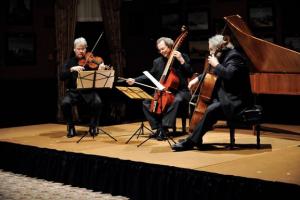Owen Morse-Brown apresenta em seu site um baryton "barroco", baseado no de Hans Kögl (Vienna 1679) que é muito parecido com o de Magnus Feldlen (Vienna 1656). Tem braço de desenho próprio e a figura de Orfeu tocando a lira sobre o cravelhame baseada no baryton de Jacques Sainprae (Berlim ca. 1720).
E dois barytons "clássicos", baseados nos dois Stadlmann (J.J. e D.A.), um com a cabeça de um guerreiro coreano (a encomenda é de um músico sul-coreano) e o outro com uma cabeça de leão, este tocado por José Manuel Hernández do Trio Baryton de Madrid. São belos instrumentos (com ressalva para a escultura do leão e o rosto de Orpheu, não totalmente de meu gosto, mas o guerreiro é estupendo). Ambos têm 6 + 10 cordas; laterais e fundo de bordo olho-de-passarinho [maple birds-eye], beiradas com peças alternadas de ébano e holly [azevinho]; ornatos baseados em instrumentos de Joachim Tielke, um deles de 1686, do Museu Victoria e Albert, de Londres.
* * * * * *
Detalhes e fotos do site dele:The baroque baryton is principally a self accompanying solo instrument with its plucked strings tuned one octave below those of the more familiar classical instrument. This means the plucked strings provide a bass line accompaniment to the bowed gut strings which are tuned in the manner of a lute - A, d, f/f#, a, d', f'. The instruments that survive from the 17th century on the whole have 9 or 10 wire strings that are tuned with wrest pins set into the bridge. However, contemporary sources do mention instruments with up to 18 wire strings including some with a third manual of strings to the left of the fingerboard. The instrument pictured here has 16 enabling much of the repertoire to be played without having to retune too often. The body of this instrument is copied from an instrument by Hans Kögel (Vienna 1679) which is also very similar to one by Magnus Felden (Vienna 1656) now in the Royal College of Music Instrument Museum in London. The neck is to my own design and the figure sitting on the pegbox is from an instrument in the Victoria & Albert museum by Jacques Sainprae (c. 1720) I would be happy to work on instruments with more plucked/sympathetic strings including those with a third manual too.






 http://www.owenmorse-brown.com/baroquebaryton.htm
http://www.owenmorse-brown.com/baroquebaryton.htmThese are
classical barytons based on instruments by the Stadlmanns (D. A. Stadlmann c.1715 & J.J. Stadlmann 1750 - once in the possession of Haydn's patron Prince Nikolaus Esterhazy). They have six bowed strings at the front tuned in the same way as a bass viol, and 10 wire (brass & iron) sympathetic/plucked strings that run underneath the bridge and behind the fingerboard. These are tuned A, d, e, f#, g, a, b, c#', d', e'. The repertoire consists of over 100 trios (baryton, viola, violoncello), solos, duos, quintets, octets, concertos and a cantata by Haydn as well as divertimentos and duets by Tomasini, Purksteiner and Neuman. Composers such as Deleschin, Giuseppe di Fauner and Fiala also contributed to the repertoire with unaccompanied works, songs, quintets and duets.
The first instrument pictured has a Korean warriors head (made for a customer in South Korea) with fingerboard and tailpiece decorations based on designs from instruments by Joachim Tielke. The second instrument pictured has a lions head and a fretted string cover both of which are again taken from an instrument by Joachim Tielke (1686) now in the Victoria & Albert Museum in London. The back and sides of both are made from birds eye maple and the edging is made of alternate pieces of holly and ebony.
These instruments can also be made with 7 bowed strings and up to 18 wire strings.
String length 67.5cm]
















 http://www.owenmorse-brown.com/classicalbaryton.htm
http://www.owenmorse-brown.com/classicalbaryton.htm





























































